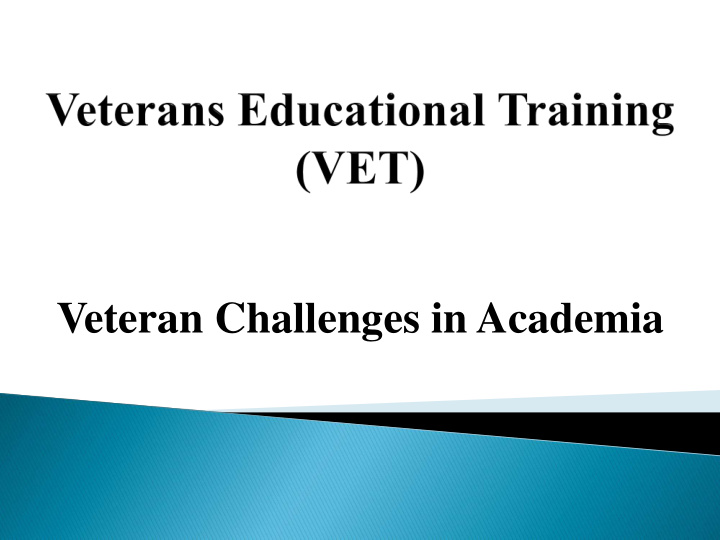



Veteran Challenges in Academia
Introduction
Challenges Statistics 55,739 Veterans in ND 6,415 Veterans in Ward County 237 Minot State Veteran Students (Spring 2015) Veteran homeless rate decreased 17.2% from 2009- 2012, still approximately 62,619 average daily (U.S.) (U.S. Department of Veteran Affairs, 2014)
Challenges Statistics (Northwest MN, ND, Northern SD) 118,582 Veterans in “Target Area” Did not complete high school (Over age of 25): 12.6% Completed high school – no postsecondary education: 34.06% Incomplete postsecondary education: 32.76% Complete postsecondary education degree: 20.49% VET Average grade level starting: (college entry is 12.9) 10.3 math, 10.5 language, 11.5 reading U.S. Census Bureau, (n.d.)
Challenges What Program(s) am I Eligible For? Chapter 30 (Montgomery GI Bill) Chapter 31 (Vocational Rehab) Chapter 32 (VEAP) Chapter 33 (Post 911 GI Bill) Chapter 35 AD, Guard, Reserve TA Kickers Yellow Ribbon Programs FAFSA Job Service Programs Scholarships (just to name a few)
Wanted!!!! Who am I?
Look Familiar?
Wanted!!! Who am I?
Challenges May Struggle with effects of deployments, current/past (emotional, physical, social, and occupational)
Challenges Have difficulties relating to other students Non-Traditional Frustration over anti-military sentiments (students/faculty/staff) Lack of Structure Don’t want to be “special” Feel invisible on campus Lack of sense of community Lack of self-advocacy (University of Texas at Austin, 2012)
Challenges Some have unique needs One in six have PTSD, major depression or anxiety 60-80% Blast Injuries Iraq/Afghanistan Vets have/had Traumatic Brain Injury (TBI) Nearly 40% of recently separated veterans attending college have some kind of disability Question: Largest Physical or Mental Health Disability? (Fischer, 2010)
Challenges PTSD Occurrence PTSD Occurrence civilians 7-8% PTSD Occurrence Vietnam Vets 30% PTSD Occurrence 1 st Gulf War (Desert Storm) 10% PTSD Occurrence 2 nd Gulf War (OIF, OEF) 11-20% (U.S. Department of Veteran Affairs, 2014)
Impacts of PTSD & TBI Musculoskeletal trauma Neurologic trauma Psychological trauma Concentration Short/long term memory loss (Sumerall, 2011)
Challenges Suicide 22 Veterans Commit Suicide a day (2013) National Guard highest suicide rate 28.1/100,000 (2012) Civilian sector suicide rate 12.3/100,000 (2011) ND National Guard 16 suicides (2003-2012) (Assist Training) (Assist Training)
Affects not only the Veteran but also: Spouses Parents Children Friends Neighbors Community
Want a checklist Reluctant to ask for help Initially enroll in 12-18 semester credits Believe a “C” grade is failing Self destructive behavior Express comfort in dangerous environments Mistrust in counseling and bureaucracies (The Man) (University of Texas at Austin, 2012)
Actively seek out Veterans Listen to the Veteran’s wants and needs Advise and tutor for certification or degree Provides safe, non-confrontational atmosphere Work with Veteran to apply for applicable funding Advise, counsel and assist in problem solving Proactive on campus, in communities & state Refer to appropriate agencies
College VA Certification Official County Veteran Services Officer (CVSO) University Counseling Services ND Department of Veteran Affairs Veterans Administration Job Service (Veteran Consultant) Mobile Vet Center Various applicable help agencies
Conclusion
References
Recommend
More recommend